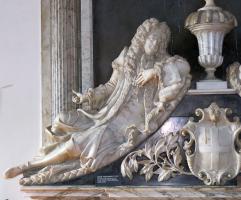
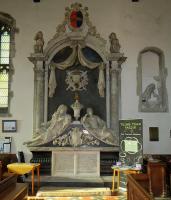
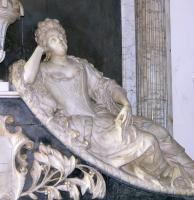
Sir William Gore, d.1707, and Dame Elizabeth Gore, d.1705.
Sir William Gore, d.1707, and Dame Elizabeth Gore, d.1705.


In the Parish Church of St Peter and St Paul, Tring, Hertfordshire, is the grand monument in white marble with dark streaks to Sir William Gore, d.1707, and his wife Dame Elizabeth Gore, d.1705. It includes full sized statues of the couple, and behind and above them, a tall canopy, with flanking pillars topped by mourning cherubs, a curved pediment, and hanging drapes.
At this time, great personages were sometimes shown reclining as here previous generations had made sculptures of the dead, lying flat, and later kneeling and praying, but during the 17th Century reclining and standing figures began to appear, first rather stiff, then in more naturalistic poses. The aim now was to show the subjects as they were in life, a little idealised perhaps, relaxed, conversational, a little informal.
Detail of Sir William, and different aspects of Dame Elizabeth.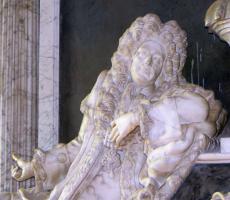
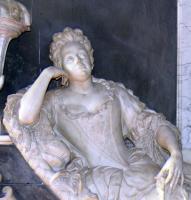
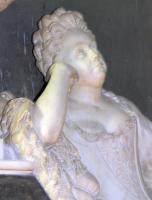
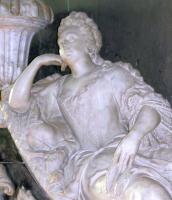
So here we have Sir William Gore, resting on some sort of thin mattress curved upward, making a comfortable seat, his body and leg stretched along it, an elbow resting on top of it, hands in theatrical pose. The informality of how he sits contrasts with the richness of his clothing, fur-trimmed robe, sleeves with enormous cuffs, chain of office, breeches to the knee to show his calf (the male leg being an object for display at this time), and high heeled shoe. He wears a full wig whose curls reach down to his chest.
Dame Elizabeth Gore reclines on the other side, her pose equally relaxed but different, her upper body as much upward as forward, her gaze indeed quite raised, as if she is lost in thought, her cheek leaning on one hand, the other playing with some embroidered bit of drapery. She wears a tight bodice to flatter her figure, lacy at the edge, embroidered with flowers at the front, carved in very low relief, loose and bulky sleeves, and a heavier lower skirt down to her feet and with a fringe at the bottom; one elegant shoe, its heel no higher than her husband s, protrudes from underneath (see pictures at bottom of this page).
Between the couple is a tall flaming urn, and on the broad, roughly triangular space below, is a shield of arms and crossed olive branches. Behind the couple is a tall, black backing panel, arched, with hanging drapes caught up at the side, and the central space containing a military hat with crossed swords and leafy branches. Around this central panel are the tall, fluted Corinthian pillars to the sides, and a round-headed frame to the arch, which could be described as a completely broken curved pediment. On top of this in central position is a painted shield of arms within a cartouche, with nicely carved flowers and fruit hanging down to the sides, and seated above each pillar is a mourning cherub, brushing their plump faces with handkerchiefs, the only sign of grief in the whole monument.
Carved details: mourning cherub, flowers, cartouche and monstrous head, delicate hand.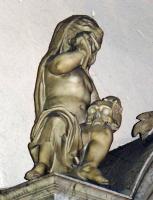
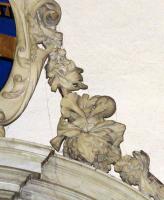
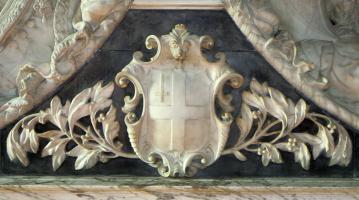
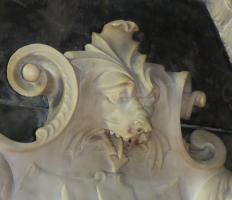
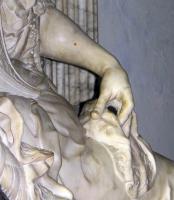
As seen from the front, then, the viewer could be having an audience with Sir William and Dame Elizabeth, he in converse, she listening or abstracted. The focus is on the figures, the frame however giving grandeur and a sense of place to the couple. The symmetry of the whole piece allows for quite a difference between the two figures without upsetting the balance, which is important, as there is a greater mass to his figure, and particularly his head with its large periwig, so if we look just at the figures, there is a slight imbalance to the left. Their arms are in different positions, but the compositonal lines of their hands converge to a single central point, and each figure has a satisfying curve to the posture defining the composition as a whole.
The inscribed panels below the figures note Sir William s various offices: Lord Mayor, magistrate, Governor of the Hamburgh Company, and merchant, and give high praise to the personal virtues of both husband and wife. And Dame Elizabeth is described as Descended from Worthy Ancestors; whose Honoured names are not recited because She wanted no borrowed lustre . The monument was put up by one of their sons, also called William Gore. A picture is below - click to enlarge to read the full inscription.
The sculptor of this work is not known. The Church website ascribes the Gore monument to Grinling Gibbons (1648-1721) or one of his pupils, 'because of his signature pea-pod hidden in the foliage'. But this too is speculative and pea-pods and similar things are not confined to Gibbons. Mrs Esdaile, pioneer of the study of English church monuments, ascribed this one to the great Flemish-born sculptor John Van Nost, who settled in London by 1686. This would be Nost the Elder, for his yard in Haymarket passed to his cousin, John Nost II, when he died in 1710. Nost the Elder is best known for lead garden statuary, but made monuments - likely many monuments - but few were signed, and while it is entirely plausible, the attribution of the Gore monument to him would have been solely on stylistic grounds. Having said that, both Gibbons and Nost had links with the Quellin family of sculptors, and Nost even worked for Gibbons on sculpture for Windsor Castle.
High heeled shoes of Sir William and Lady Elizabeth.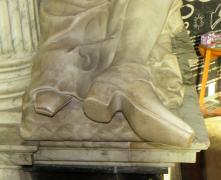
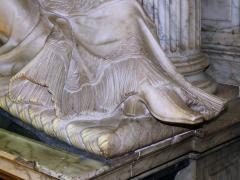
There are a number of these splendid monuments with reclining statues from the late 17th and early 18th Centuries, with bewigged nobility under grand canopies, and this website notes for example the William Hicks monument in Leyton Church, the William Scawen monument in Carshalton Church, and the Richard Ladbroke monument in Reigate Church.
With many thanks to the Revd. Huw Bellis for kind permission to use pictures of the William Gore monument in Tring Church; see the Church website at http://www.tringteamparish.org.uk/tring-history/4588959395.
This page was originally part of a 'sculpture of the month' series, for October 2016. Although the older pages in that series have been absorbed within the site, if you would wish to follow the original monthly series, then jump to the next month (November 2016) or the previous month (September). To continue, go to the bottom of each page where a paragraph like this one allows you to continue to follow the monthly links.
Introduction to church monuments // Angel statues // Cherub sculpture
Sculpture in some towns in England
Visits to this page from 1 Oct 2016: 5,037